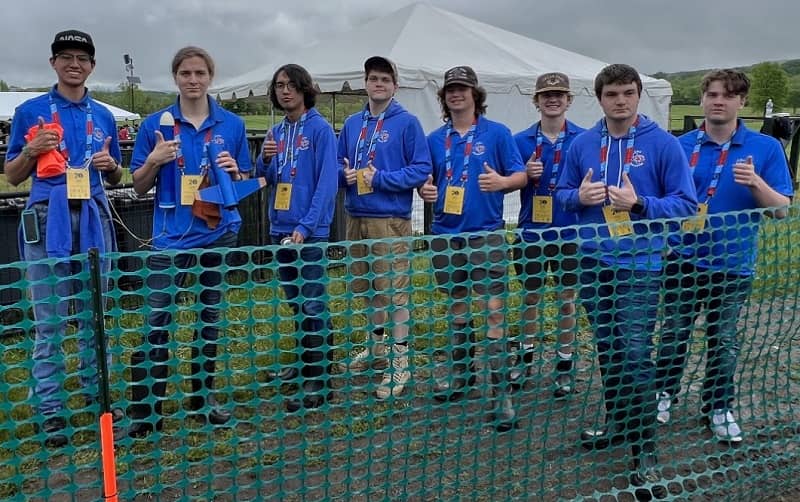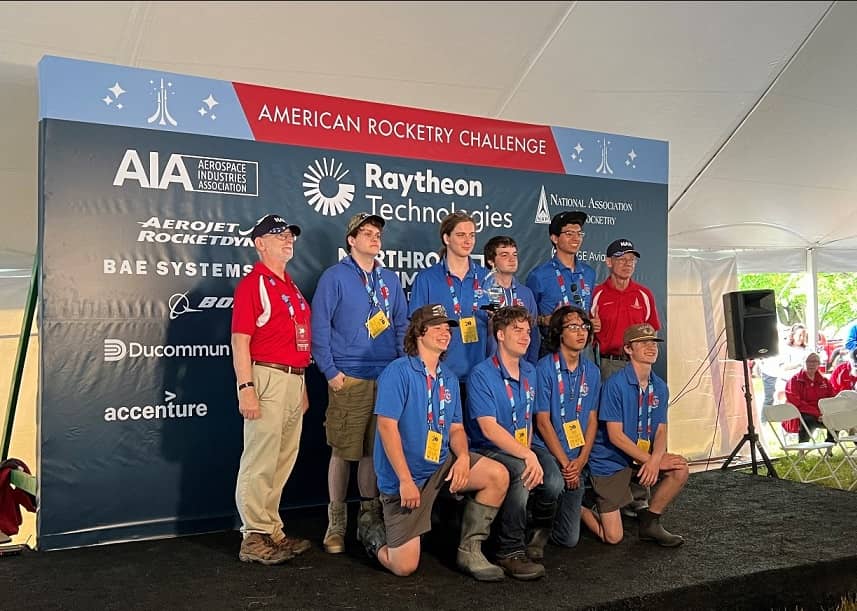
The Plains, Va. – Coleman High School students were awarded 5th place at the world’s largest student rocketry competition – the American Rocketry Challenge. Coleman High School was one of 99 teams competing at the National Finals, which took place at Great Meadow in The Plains, VA. In total, 724 teams from 41 states competed in the 2022 American Rocketry Challenge. The students earned $7,500 of prize money as a result of their achievement. In addition, as a top-25 finisher, the team earns an invitation to participate in NASA’s Student Launch initiative.
Coleman High School has sent teams to the Challenge since 2015, but this is their first time returning to the finals since 2016. The team was composed of senior members Lukas Puryear, Wyatt Puryear, Chris Ely, Nick Tovar, Montana Holton, and Cris Mares, and junior members Bode Slayton and Gunner Gordon. They were advised by Coleman High School physics teacher Gary Strickland.
The team’s accomplishment follows months of preparation designing, building, and testing a rocket capable of meeting rigorous mission parameters set by the contest’s sponsors – the Aerospace Industries Association (AIA), National Association of Rocketry, and more than 20 industry partners. To qualify for the National Finals, teams were required to build and launch a rocket that safely carries a payload of two raw eggs with a target flight duration of 41-44 seconds and altitude of 835 feet. At the National Finals, competing teams had to launch the rockets to 810 feet with a flight duration of 40-43 seconds in the first round of competition. The top 42 teams conducted a second launch that was required to reach 860 feet with a flight duration of 42-45 seconds.
Teams at the National Finals represented 27 states from Hawaii to Connecticut and competed for a total of $100,000 in prize money and scholarships. The top 25 finishers receive an invitation to participate in NASA’s Student Launch initiative to continue their exploration of rocketry with high-powered rockets and challenging mission parameters. Winners of the Marketing Competition, Presentation Competition, and Best First Time Finalist were also honored at the National Finals.
2022 marks the 20th year of the American Rocketry Challenge, and the first time since 2019 the top teams competed in a National Finals launch. The National Finals were cancelled in 2020 due to COVID-19, and in 2021 teams competed in 10 Regional Finals located in sites across the country – also a precaution implemented as a result of the pandemic. To date, the American Rocketry Challenge has inspired more than 85,000 middle and high school students to explore education and careers in STEM fields.
For more information and content, check out the official #RocketContest22 web, Facebook, Twitter, and Instagram pages. You can view the press release announcing the winner of the competition here.

Team Adviser Perspective By Gary Strickland
Congratulations to the Coleman High School rocketry team for their 5th place finish in this year’s American Rocketry Challenge. The team is made up of seniors Lukas Puryear, Wyatt Puryear, Cristian Mares, Chris Ely, Nick Tovar, and Montana Holton. Two junior members are Gunner Gordon and Bode Slayton. I want to offer my perspective on the work this team did that led to their achievement this past weekend. I am their research and design teacher and rocketry mentor. I hold a level 2 high power rocket certification. When most of us hear “rocketry” and “students” we tend to think of the model rockets that are sold in box stores.
TARC is an acronym for The America Rocketry Challenge. This competition is administered by the Aerospace Industries Association (AIA). They are a trade association representing the nation’s leading aerospace and defense manufacturers and suppliers. They are the authoritative voice on issues of civil and commercial space, commercial aviation, defense and security, and national airspace systems.
TARC is a contest that requires precision in every detail. “Good enough” is never good enough. Each year AIA releases unique contest rules that specify both the design criteria and the performance goals of the rocket for that year. Each year is different. Rockets cannot be assembled from kits. Students are required to design and build a rocket from scratch. The rocket this year had to weigh less than 650 grams (~1 ½ pounds). The rocket had to have two diameters (one body tube of the rocket bigger than the other) and be at least 65 centimeters in length (~ 2 feet). It had to carry two large chicken eggs oriented horizontally in the rocket. The students used hand and power tools, 3D printers, and laser cutters to fabricate their rocket. The rockets must be tough. One must also realize that a rocket launch is a violent event. By the time the rocket is 6 feet off the ground, it has accelerated to almost 300 mph. Internal parts are under the stress of 12 g’s (12 times the normal force of gravity). Their rockets are tough enough to endure the stress of 20+ flights before failure.
The target altitude for qualification was 835 feet and the rocket had to be in the air between 41 and 44 seconds. When the students qualified this year, they missed their target altitude by 3 feet on their 1st flight and 5 feet on their second flight. These phenomenal scores earned them a place in the top 100 teams that advance to the national fly-off.
There was a new challenge in this year’s finals competition. In an effort to ensure that the top teams truly understand how to manipulate and control their rockets, the AIA declared there would be two different altitude and time targets for the national flights. One altitude would be 810 feet and a time of 40-43 seconds. The second altitude would be 860 feet and a time of 42-45 seconds. The order of the flights was determined by a coin toss at the competitors meeting on Friday night. This coin flip determined the first altitude to be 810 feet and 40-43 seconds from launch to landing.
So here is what the students have to consider:
The thickness of our atmosphere (the air density) changes constantly. The variables that affect the density are temperature, humidity, barometric pressure, and altitude above sea level. Rockets have to push through this air to reach their assigned altitude. Our rocket motors have a fixed total impulse – the motor thrusts with a certain force for a fixed amount of time. So as the air changes, rockets fly higher or lower depending on how thick the air is at that moment in time. These students have to determine how “slippery” the rocket is in the air. This is the drag coefficient of the rocket. Then they make calculations using software to determine how high the rocket will fly.
There are only two adjustments students can make – knobs they can “turn” – to change the altitude of the rocket. They can add/ remove drag to change how “slippery” the rocket is in the air, or they can change the weight of the rocket. Changing weight has limitations because the rocket necessarily weighs a certain amount when built – and the contest specifies the weight cannot exceed 650 grams.
To hit 810 feet the team had to adjust both weight and drag on the rocket. They also had to choose a parachute with the correct descent rate to meet the flight duration time goals. The parachute is deployed with an explosive charge on the motor. The students actually modify this ejection charge to deploy the parachute at a specific time in flight.
On the first flight they missed the target altitude by 9 feet and were only .28 seconds outside the time window. It’s interesting to note that rocket motors are guaranteed to perform within 1% of their published performance specifications. This flight was within the limits of the published precision of the motor.
The second flight was later in the day and the goal was 860 feet with a time window of 42-45 seconds. The team made changes to the weight and drag and chose a different parachute. At the time they flew there was light rain and wind. The temperature and humidity were changing. They adjusted the rocket three times before launch to compensate for the changes in conditions. They also had to change out a faulty ignitor. They were 10 feet off of the target altitude and perfectly inside their time window. Once again, their results were within the manufacturing tolerances of the motor.
Our combined score of two flights was 20.12. The score of the 1st place winning team was 13. Let me give you some perspective of just how close those scores really are…
The team flew two flights to different altitudes with different time windows in variable weather including rain and gusting winds. Now imagine how heavy 5 small paper clips are; not much right? If they had changed the weight of either rocket by removing that much divided into either flight – their score would have won… That’s not said to complain – it’s just to give you a mental image of just how close the top 5 teams were in performance. All the top 5 teams were within the performance limits of their motors as well.
My view is they made all the right decisions. There is absolutely nothing they could have done better. There are a couple of quotes from the trip I’d like to share. The first is by a good friend that is a high-power certified rocketeer. After watching the team, he said, “They have ice water in their veins.” Clearly, he was impressed with their calm demeanor and careful attitudes. The second quote was by my wife. At one of the flight museums she commented, “I see too many ways to fail.” Her point was to highlight how many things must be done right for flights to be successful. Rocketry and TARC are indeed endeavors requiring precision. If you consider the number of teams that registered and competed in this year’s challenge, Coleman High School was in the top 0.6%. I could not be prouder of them.
I’d like to thank Herma Jean Johnson for her continued support of these students by allowing us to fly on her property. She was a dedicated teacher and continues to support education. Thank you David Avants for your support. Thank you to Coleman ISD Board of Trustees, Brandon McDowell, and Diana Dobbins for supporting this program. Thanks to the Coleman ISD ACE program that was the genesis of the rocketry program. I’d like to also thank Pat Gordzelick and Andrew Grippo for mentoring me so that I might be able to help the students.

